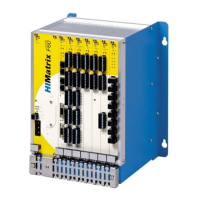6 User Program System Manual Modular Systems
Page 46 of 114 HI 800 191 E Rev. 2.02
6.5.3 Restriction to the Use of Forcing
The following measures can be configured to limit the use of forcing and thus avoid potential
faults in the safety functionality due to improper use of forcing:
Configuring different user profiles with or without forcing authorization
Prohibit global forcing for a resource
Prohibit local forcing or entering new process values.
Forcing can also be stopped immediately using a key switch.
To do so, the Force Deactivation system variable must be linked to a digital input connected
to a key switch.
This system variable is not always enabled, see Table 22.
Force Deactivation prevents global and local forcing from being started and stops
an on-going forcing process.
Force Deactivation prevents global forcing from being started and stops an on-
going forcing process.
Force Deactivation inhibits the Edit Local Process Values command, but it does
not reset changed local variables to their previous process value.
Table 22: Effect of the Force Deactivation System Variable
6.6 Forcing - CPU OS up to V7
The force value is stored in the controller. If the CPU switches from RUN to STOP, the forcing
procedure is deactivated to ensure that the controller does not accidentally start with active
force signals.
Absolutely take the following facts into account when forcing or evaluating tests
performed with forced global variables:
Signal force values are only valid until overwritten by the user program!
However, if the user program does not overwrite the values, e.g., if an EN input is set to
FALSE, the force value is used as a process value in the ensuing calculations.
Online test fields associated with forced signals may therefore show the forced value, even if a
value generated by the user program has already been used in the ensuing calculations or is
effective on an output.
6.6.1 Time Limits
It is possible to set a time limit for the forcing procedure. A configuration parameter defines how
a controller should behave once the force time has expired:
The processor enters the STOP state.
The force value is no longer valid and the controller continues its normal operation.
In any case, overrunning the force time affects the user program and thus the process.
Forcing is terminated upon expiration of the force time or when forcing is intentionally stopped.
Provided that Stop at Force Timeout is set in the resource's properties (see also message in
the info field), the controller enters the STOP state after the force time has expired and the user
program continues to run with the process values.
If Stop at Force Timeout is not set, the controller is not stopped after the force time has
expired. Forcing is deactivated and the values previously forced (R force values) are replaced
with their process values.
This may have unintentional effects on the overall system.

